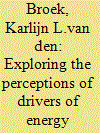|
|
|
Sort Order |
|
|
|
Items / Page
|
|
|
|
|
|
|
| Srl | Item |
| 1 |
ID:
092737


|
|
|
|
|
| Publication |
2009.
|
| Summary/Abstract |
The Fourth Assessment Report of IPCC reports that greenhouse gas emissions can be reduced by about 30-50% in 2030 at costs below 100 US$/tCO2 based on an assessment of both bottom-up and top-down studies. Here, we have looked in more detail into the outcomes of specific models and also analyzed the economic potentials at the sectoral and regional level. At the aggregated level, the findings of the IPCC report are confirmed. However, substantial differences are found at the sectoral level. At the same time, there seems to be no systematic difference in the reduction potential reported by top-down and bottom-up approaches. The largest reduction potential as a response to carbon prices exists in the energy supply sector. Reduction potential in the building sector may carry relatively low costs. Although uncertainties are considerable, the modeling results and the bottom-up analyses all suggest that at the global level around 50% of greenhouse gas emissions may be reduced at carbon price (costs) below 100$/tCO2-eq-but with a wide range of 30-60%. At a carbon price (costs) less than 20$/tCO2-eq, still 10-35% of emissions may be abated. The variation of results is higher at low carbon-price levels than at high levels.
|
|
|
|
|
|
|
|
|
|
|
|
|
|
|
|
| 2 |
ID:
166517


|
|
|
|
|
| Summary/Abstract |
Many models have been applied to predict energy use and savings, yet few studies have investigated people's own perceptions of what drives their energy use. Understanding these perceptions can help design energy policy that is likely to be trusted and perceived as credible. This study assessed the perception of the drivers of energy use among young adults, who had recently become independent energy consumers, but were not yet paying for their energy bills. Focus groups were conducted in which the drivers of energy use were discussed, and discussions were analysed using a framework of a successful existing behavioural model – the Comprehensive Action Determination Model – that includes both conscious and unconscious drivers of energy consumption. The findings show (1) participants did not tend to believe they saved energy to conserve the environment, (2) adherence to egoistic values, apparent in the lack of motivation to save energy in the absence of financial incentives, and (3) strong awareness of energy habits. Policy makers targeting young adults' energy use are advised how to align energy policy with these perceptions.
|
|
|
|
|
|
|
|
|
|
|
|
|
|
|
|
| 3 |
ID:
162297


|
|
|
|
|
| Summary/Abstract |
Energy systems are undergoing a significant shift to renewable energy (RE). To date, the surface area required for RE systems is greater than that for non-RE systems, exacerbating existing environmental policy challenges, from increasing land competition, to visual impacts. A suitable metric for comparing the extent of systems is the power density of electricity production, that is, the electrical power produced per horizontal m2 of surface area. This study systematically reviews power densities for 9 energy-types (wind, solar etc.) and multiple sub-types (e.g., for solar power: PV, solar thermal) in the United States. Median, mean, and uncertainty estimates are provided for 177 different densities from the literature. Non-renewable power densities are found to be three orders of magnitude larger than renewable densities. Natural gas and solar energy yield the highest median density per non-RE, and RE system respectively. Solar energy was the only system to experience a significant, positive relationship in power density over time. We apply these density estimates to NREL scenarios of future energy systems for state-specific assessments, and find that the largest growth in land use is in the southern United States.
|
|
|
|
|
|
|
|
|
|
|
|
|
|
|
|
| 4 |
ID:
103351


|
|
|
|
|
| Publication |
2011.
|
| Summary/Abstract |
Aiming to lead amongst other G20 countries, the UK government has classified the twin energy policy priorities of decarbonisation and security of supply as a "centennial challenge". This viewpoint discusses the UK's capacity for energy modelling and scenario building as a critical underpinning of iterative decision making to meet these policy ambitions. From a nadir, over the last decade UK modelling expertise has been steadily built up. However extreme challenges remain in the level and consistency of funding of core model teams - critical to ensure a full scope of energy model types and hence insights, and in developing new state-of-the-art models to address evolving uncertainties. Meeting this challenge will facilitate a broad scope of types and geographical scale of UK's analytical tools to responsively deliver the evidence base for a range of public and private sector decision makers, and ensure that the UK contributes to global efforts to advance the field of energy-economic modelling.
|
|
|
|
|
|
|
|
|
|
|
|
|
|
|
|
|
|
|
|
|